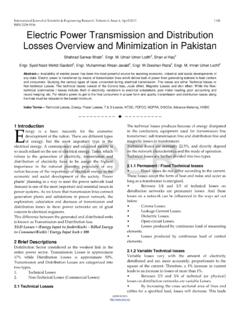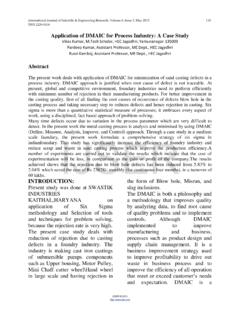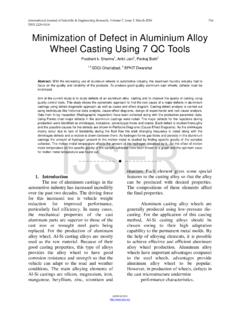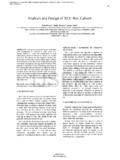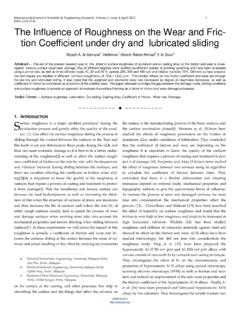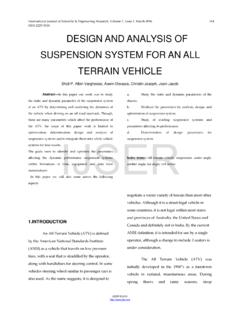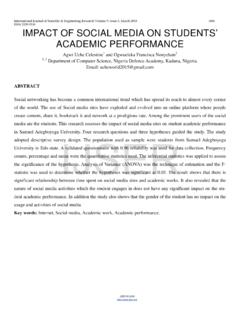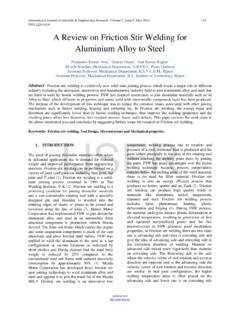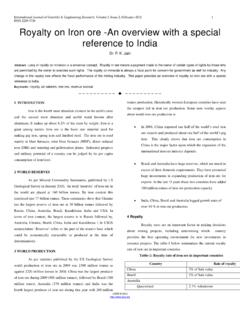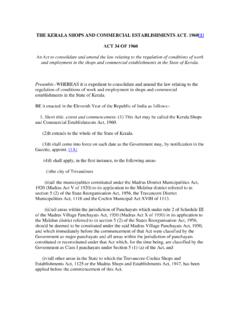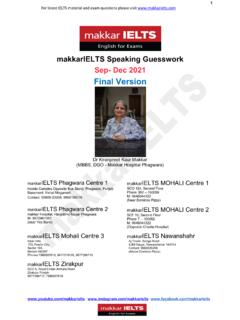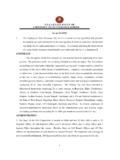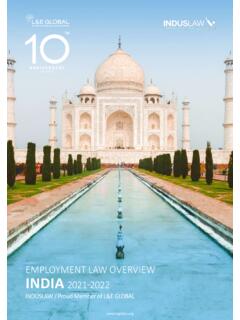Transcription of Redefining Cultural Identity Through Architecture
1 Redefining Cultural Identity Through ArchitectureUnderstanding the influence of culture on house forms in different community settlements in Fort Cochin, kerala Ashfina T Department of Architecture College of Engineering, Trivandrum Trivandrum, kerala , India Email: Abstract The culture and Architecture are two interlinked concepts that help man to evoke Identity as an individual and a social being. Existing studies reveal that a person s or a community s Identity in a particular setting can be expressed Through Architecture . It is possible to create spaces with differences in spatial organization, street pattern, landscaping features, etc., according to the lifestyles, beliefs, rituals and customs of the inhabitants which finally becomes the Identity of that particular place. But what happens to the Identity of a place when all the inhabitants are migrants who left their homeland for better education or job opportunities and settled in a location where all social - Cultural aspects are different from theirs?
2 This paper explores how the Architecture evokes the Identity of five different migrant communities in Fort Cochin and Mattancherry, kerala , without affecting the indigenous style of the location and the character of the total culture; Architecture ; Settlements; Identityhave been carried out on this topic which reveals that the Architecture can be used as a good medium to represent people in any area if properly planned and designed. This paper examines the relationship between culture and built form of migrant communities in kerala , with particular focus on the settlements and house forms in Fort Cochin and Mattancherry. The main aim is to identify those elements and features of a particular settlement which evokes or enhances the Identity of its inhabitants. II. THE CULTURE AND BUILT FORMIt is very clear that the planning and design of any built space require an idea about the activities and requirements of people who are going to perform there.
3 These requirements are always derived from their lifestyles, thought patterns and social needs based on their culture, traditions, and customs. So the spaces where people live must be a reflection of their culture. In this manner, the Architecture and the Cultural aspects can be correlated. I. INTRODUCTION Culture and built spaces are two interlinked concepts which help man to create meaningful environments with unique Identity which is expressed Through its elements and features. These concepts help man to enjoy his living environment and also evoke a sense of belongingness among the members of a particular community. But in the present scenario, due to several reasons like urbanization, uncontrolled population growth, etc., many people migrate from their homeland to an urban area for better living conditions and job opportunities which lead to a loss of Identity of the community and their settlement.
4 These migrants adjust to the available Fig. 1. Relation between culture and built form conditions of the new location and are least concerned about this Identity loss. They are more concerned about the job, education, economical status etc. which causes to lose of our valuable traditions and culture that our forefathers left with us. It is true that the change is inevitable in the modern era, but it has to be in a healthy way so that the harmony between the man and his environment has to be maintained. Many studies International Journal of Scientific & Engineering Research, Volume 5, Issue 7, July-2014 ISSN 2229-5518159 IJSER 2015 FORT COCHIN AND MATTANCHERRY: A COMPOSITION OF CULTURE AND Architecture Fig. 2: Location Map of Fort CochinFort Cochin is a small township in Ernakulum District of kerala state which has a unique and rich Cultural background evolved from foreign influence in its earlier periods.
5 The rise of Fort Cochin had started with a flood in Kodungallur which caused to develop a new port in Cochin for the trade purpose. This township is considered to be the first European colony in India which grew rapidly into a large trade centre by attracting many trading communities, including Muslims, Jews, Jains, Hindus, and Christians. The Identity of the city is enhanced by the presence of these 13 ethnic communities and the architectural style of their settlement. The analysis of the city as a whole and each settlement in particular (based on socio- Cultural aspects) has been made to find out the influence of Architecture in creating a Cultural Identity of this area. A comparison of the spatial structure in distinct settlements has been made to understand and describe much regarding the spatial character of Cochin which further helped to draw conclusions. A. Culture as a Determinant of Urban Form: Spatial Structure In any urban area, it is necessary to have some driving force for the development of both space and society.
6 In Fort Cochin, the trade and the different community migrants were the driving force for its overall development. The most striking feature of this town is its built environment with its unique Identity . Each and every settlement of this area has certain architectural elements/ features which imparts to this uniqueness. Even though the settlement pattern and its architectural characteristics in this area are highly influenced by the colonial rule and the lifestyle of different migrant communities, it maintained its Identity with proper integration of the indigenous style of kerala . An architectural analysis of this area brings out many common features which bind them as a single unit without losing the uniqueness of each community settlement and reflect the lifestyle and culture of its inhabitants. A few of them are mentioned below: x Built from-street relationship: The ratio of street width to building height has been maintained at 1: 1 or 1: 2 which ensures a sense of spaciousness and compactness.
7 This arrangement evokes a sense of safety and security for the users by which the city developed as a Cultural composition. : Pristine road as a symbol of colonial rulex Mixed land uses: Most of the people are engaged in trading activities and they preferred to live in a group near to their activity area for safety and security reasons. Depending on the occupation and activity pattern, each settlement is composed with mixed land uses which make it more active and alive. x Architectural Typology: Four types of house forms have been found here; all derived from the basic traditional house form of kerala - Nalukettu which has a courtyard in the centre which is used for various purposes. They are Street Forms (row houses arranged linearly along the street), Bungalow Forms (individual bungalows with landscaped area and sea view), Row House Forms (away from the street, but connected Through inner streets), Court Yard Forms (Many Houses arranged around a courtyard).
8 This courtyard form is common in Industrial buildings also. x Height of Building: All the buildings are single or double storied. In the Raw house for the labourers, it has been kept single storied while those accommodating traders have two storied structure with commercial space on the ground floor. The administrative Buildings are also two storied, but the floor height is slightly higher compared to other buildings which expresses status and power. A few buildings go up to three stories in this city. : Building Typology at Fort CochinIV. Cultural Identity OF DIFFERENT SETTLEMENTS IN FORT COCHIN: Fort Cochin is probably the only area in kerala which shows a social culture mix of 13 ethnic groups with their own International Journal of Scientific & Engineering Research, Volume 5, Issue 7, July-2014 ISSN 2229-5518160 IJSER 2015 , customs, lifestyles etc.
9 They are mainly migrant B. Jews Settlement: - communities who came for trade and commerce. In this paper five different settlements are analysed, including Tamil Brahmin s, Jews , Gujarati s, Konkani s and The Kutchy Memons settlements. A. Tamil Brahmin settlement (Agraharam): - Fig 5 : Settlement Pattern -AgraharamTamil Brahmins are one of the most influential of the non indigenous communities that migrated to Cochin when theking invited them for conducting royal religious functions. So they settled near to the temple and their daily ritual starts with a visit to the temple. This settlement is a multiple family settlement with linear house pattern .The design and layout are guided by the parameters like status in the community, association with the temple and their patronage of the royals. Main controlling element in settlement pattern is the religion and their customs. They give more importance for interactions within the community and prefer to live in groups for safety and security reasons.
10 The water body is an important element in the overall setting of the Agraharam as the inhabitants follow the Vedic life with a belief of spiritual and physical purity. This street is strictly pedestrian and bounded by a compound wall with an entrance gate to prevent the entry of non- Brahmins. Most of the interactions and functions occur in these streets. So this street acts as an extension of their living space. Fig 7 A : Jew s Street Plan Fig 7 B Synagogue ViewThe history of kerala s Jews goes back to 10th century BC, when trade of various items like peacocks, ivory, sandalwood and spices etc. flourished in India. Many believe that Jews arrived in kerala after the destruction of the Second Church of Jerusalem in 70 CE. The main cause for the growth and development of this settlement was the occupation which created many spaces for their trading activities which includes shops , warehouses etc.
